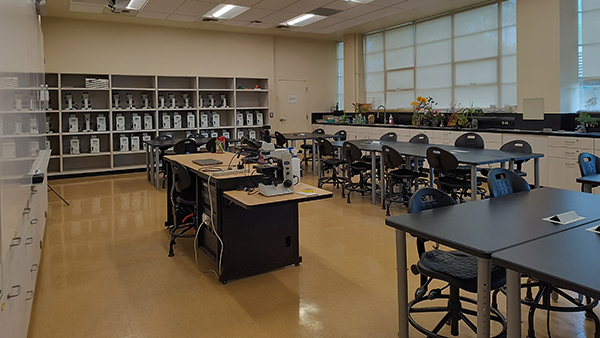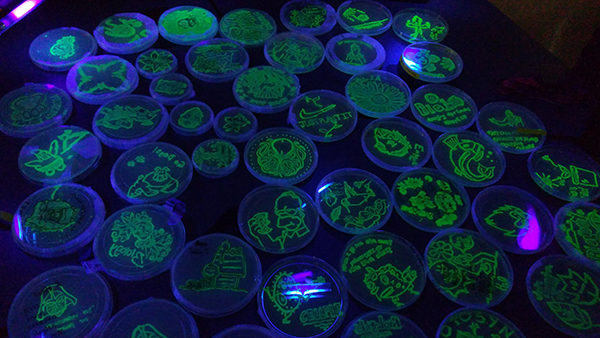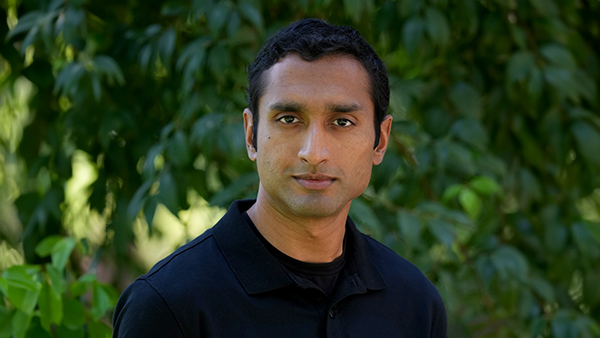|
We hope you enjoy this series where we meet and get to know employees from across campus. Would you like to be featured? Contact us at campusnews@csufresno.edu.
Name: Sanjiva Gunasekara
Title: Instructional Support Technician
Department: Biology
Academic Degree(s):
- B.S. Biology - Physiology and Anatomy option, Fresno State
- M.S. Biology, Fresno State
How long have you worked at Fresno State and in which offices have you worked?
I have been in my current position since November 2016, though I have been working in the Biology Department in some capacity since 2011, starting as a graduate student.
Are you a Valley native?
Yes, I was born and raised in Fresno. My father came to campus as an international student from Sri Lanka to study plant science in 1977. I came here as a student for practical reasons. As I was nearing completion of my bachelor’s degree, I still didn’t have a clear idea of what I really wanted to do for a career. During my senior year, I met Dr. Hwan Youn through his microbial physiology course. He suggested that I apply for the Biology Master’s Program after noticing my attention to detail and fine motor skills during the lab portion of the course. The program was a turning point in my life and opened up a world of possibilities in research, biotechnology and science education.
Are you a Bulldog family with generations of Bulldog graduates or current students?
Not quite. Unfortunately, my father did not finish his degree. However, attending this university was the primary reason he immigrated to this area of the United States.
Do you have a campus mentor or someone who has helped you in your career?
Dr. Youn, my graduate research mentor and adviser. The experiences and training I received through his research lab and the Biology M.S. program became the foundation for all of my professional endeavors. Dr. John Constable also routinely gave me guidance from the time I was a graduate student through his tenure as department chair. More recently, Dr. Alija Mujic has been supportive of my efforts to update some of our BIOL 1A lab activities.
I am also grateful to Neil Kuykendall and Charles Kronberg. Neil gave me valuable insights and training when I was an interim IST, while Charles put together a collection of materials and protocols that serve as the framework for my operations in McLane Hall. Finally, I could not effectively do my job without the continuing help of department staff members Lindasue Garner, Wayne Parent, Mark Schreiber, Wendy Cooper and Maria Rochin. Thank you all.
Tell us about your department and what people may not know about it.
The Biology Department was initially created in 1926 as the Department of Agriculture and Biology, 15 years after Fresno State Normal School was founded in 1911. Our department has been part of various “schools” since then, including the School of Arts and Sciences in 1964 and the School of Natural Sciences in 1970. We found our current home in the College of Science and Mathematics in 2000 when Fresno State’s eight schools were renamed as the eight colleges. It’s amazing to think that our department has been around for almost 100 years.
Our department also has a substantial vertebrate collection consisting of about 3,500 mammals and 2,500 birds prepared as study skins. We also have over 600 full (or partial) bird and mammal skeletons, representing 70 families and over 220 species. Since the 1800s, dozens of professors and their students (along with public agencies and the general public) have contributed specimens that are now in the collections. These specimens are an important teaching resource because they allow students to get a close-up, hands-on look at animals they might otherwise be unlikely to see.

|
|
|
What is your most notable accomplishment in your field, and why was it important?
The start of the COVID-19 pandemic created enormous challenges for delivering our existing lab program to students, which was almost entirely composed of in-person activities. Unlike lecture courses, lab activities could not simply be moved to a virtual classroom without providing adequate scaffolding for lab concepts and substantial virtual activities. Anticipating this need, I researched and curated several lab simulations from the Labster and SimUText (SimBio) biology catalogs to align with the lab curriculum of our BIOL 1A course, as well as freely available online interactives. I also created resource pages on Canvas and tutorial videos to walk lab instructors and students through some of these activities. This virtual lab program would remain essential as we offered a mix of virtual and in-person lab sections during the next two academic years.
Though our lab programs are back to being predominantly in person, our collection of virtual resources continues to be used in some capacity. I continue to look for online interactives as a means of reinforcing material learned in the classroom or to provide potential makeup activities for absent students. I’m also proud to have been on the planning committee for the redesign of McLane 225, one of our biology teaching labs, which occurred in 2022. The modernization of this teaching lab was a huge undertaking, as its original layout and amenities had remained unchanged for several decades. It’s rewarding to see our plans for the room come to fruition and to see classes being held in this updated space.
What are you most passionate about in your field and why?
I’m most passionate about improving students’ learning experiences in our lab courses (to the extent that I have the autonomy to do so) because I believe they play a role in shaping students’ attitudes and beliefs about science. BIOL 1A is a "gateway course" that science majors, or those in related disciplines, take early in their academic careers. This presents a good opportunity to develop students’ science identity and provide a window into scientific research, which many students are unfamiliar with. If anything, I hope that my efforts are helping them to develop their critical thinking abilities and interpersonal skills (many of our lab activities are done in small groups), as well as practice fundamental lab techniques (e.g., microscopy).
The second reason is that I enjoy the creative process of configuring activities that align with our curriculum; I feel a sense of accomplishment after successfully launching new lab exercises. Implementing a new activity can be challenging as many factors need to be considered (class size and schedule, my own technical abilities and those of the students/instructors, cost, and labor/prep time, to name a few). One of my first experiences practicing this was the implementation of a "pGLO" transformation activity into BIOL 1A, where students transform E. coli bacteria with a plasmid containing green fluorescent protein (GFP). The bacteria, once they uptake the GFP-containing plasmid, glow a bright green color when grown in the presence of arabinose sugar and placed under UV light. This lab was among the first which required several techniques I learned as a graduate student to complete its preparation. Though the activity is relatively simple, several materials must be prepared ahead of time and then tested. It requires a lot of time and effort, however the end result is tangible: students genetically modify/create UV-fluorescent bacteria, and many of them get their first experience performing fundamental microbiology procedures (plating bacteria using sterile technique and bacterial transformation).
We also hold an extra credit "art contest" each semester, where students use the transformed cultures to draw images on large nutrient agar plates. Most recently, I implemented an "algae beads" activity. This inquiry-based lab allows students to design their own experiment using live algae encased in a natural polysaccharide called sodium alginate. In this bead form, the algae can still perform gas exchange with their environment. Students are provided with various materials (different colored lights, germinating seeds, aquatic snails, etc.) along with a color-changing pH indicator solution that serves as a proxy for measuring carbon dioxide levels in a system. Students are then tasked with creating an experiment that explores the interplay between photosynthesis and cellular respiration (since the algae beads are capable of both processes) and use the carbon dioxide indicator solution to analyze the rate of each process occurring. There are always interesting new activities to explore or aspects of a lab that can be improved; this keeps me engaged with my work.

|
|
|
What is a memorable moment you had at your job?
Most recently, a group of students contacted me to request some lab supplies. I was very busy at the time and overlooked their email’s mention of participating in the Destination Decarbonization Challenge, hosted by the Water, Energy, and Technology (WET) Center. In this competition, groups of two to four students must create and pitch an innovative solution to accelerating decarbonization and reducing climate change. Their project involved investigating ways to measure the carbon content of soil to maximize land efficiency. To accomplish this, the students wanted me to put together a prototype apparatus that measures soil respiration using a pH indicator solution. It would only provide qualitative pH levels based on color change, and I wasn’t sure how well it would work for their application since I didn’t do a trial run beforehand. This student group competed against seven other teams and won first place in the challenge! I was pleasantly surprised by this news, and it made me realize that seemingly minor tasks can have major impacts in students’ lives.
What is a memorable moment you had in class?
There wasn’t one "moment" for me, but a series of them during the fall 2022 semester. To facilitate a California Learning Lab grant, I implemented an exercise that utilized "research deconstruction" in the lab portion of our BIOL 1A course. My idea for implementation was to have students perform some of the same techniques used by the researcher they were learning about in lecture. The relatively advanced procedure of RNA isolation in a freshman-level course initially seemed daunting to me. How could we expect freshman students to successfully perform a technique that skilled researchers sometimes struggle with? Furthermore, I only had experience isolating RNA from bacteria, not the organism we were working with, and we had limited time to implement this idea into our lab program.
My first attempt at this was unsuccessful; I was using a new extraction kit on a new organism and hoped for the best. Fortunately, I was able to successfully isolate RNA from the organism on my second attempt by modifying the amount of cell culture used and the lysis buffer incubation time. This allowed me to create a protocol for students to reproduce my results. It would still require fine motor skills and attention to detail on the part of students. Surprisingly, a few student groups successfully isolated RNA.
From there, it was a matter of troubleshooting a few components of the qPCR reaction. Through a combination of applying my research training and persistence, we successfully performed qPCR on students’ RNA isolates. This ultimately yielded usable data for their Course-based Undergraduate Research Experience reports. This was exciting because it allowed us to analyze the effects of students’ test substances on the expression of two metallothionein genes in the protozoan. Applying my training to develop a new lab experiment, integrating it with our existing activities, and simultaneously practicing the teaching philosophy of this grant felt extremely rewarding. The handful of small "moments" of victory (positive experimental results) throughout this activity’s implementation made it a memorable experience.
What is your teaching style?
I like learning by doing, and laboratory courses are a great opportunity for students to put the concepts they’re learning about in lectures into practice. If I’m training someone, I prefer to give them hands-on experience with a particular task instead of just explaining it to them. Though I’m not in a teaching role, I believe in outcome-driven education, as it emphasizes why proficiency in a particular skill or knowledge matters.
What is your favorite quote or saying?
"Don’t explain your philosophy. Embody it." — Epictetus
What is the most interesting or unusual job you've ever had?
Most of my work experience has been on campus. My current role has been the most interesting due to the variety of tasks.
What do you like to do for fun in your spare time?
I like watching anime, particularly Shōnen anime. Many of them have incredible visuals, soundtracks, and voice acting, and I’m emotionally moved by the characters and storylines. I also enjoy watching movies and playing video games for many of the same reasons.
What is something interesting about you that most people don’t know?
I was a classically trained trombonist in a previous life. I also played piano and some violin as a youth.
Is there something else you would like to share that was not asked?
I’m a serious-looking person, but I like to laugh and make jokes.
|




